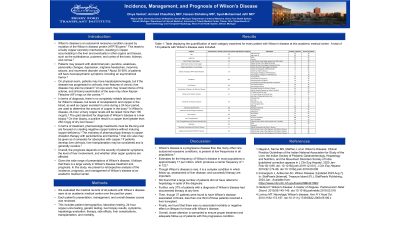Sunday Poster Session
Category: Liver
P1200 - Incidence, Management, and Prognosis of Wilson’s Disease
Sunday, October 27, 2024
3:30 PM - 7:00 PM ET
Location: Exhibit Hall E

Has Audio

Divya Venkat, BS
Wayne State University School of Medicine, MI
Presenting Author(s)
Award: Presidential Poster Award
Divya Venkat, BS1, Ammad Javaid. Chaudhary, MD2, Hassan Elshebiny, MD3, Syed-Mohammed Jafri, MD2
1Wayne State University School of Medicine, West Bloomfield, MI; 2Henry Ford Health, Detroit, MI; 3University of Toledo Medical Center, Toledo, OH
Introduction: Wilson’s disease is an autosomal recessive condition caused by mutation in the Wilson’s disease protein (ATP7B) gene, which results in an excessive copper buildup in the body. In this study, we present a retrospective analysis of the incidence, prognosis, and management of Wilson’s disease at an academic medical center.
Methods: We evaluated medical records of all patients with Wilson’s disease seen at an academic medical center over the past ten years. Each patient's presentation, management, and overall disease course was reviewed. This includes demographics, laboratory testing, 24-hour copper urine testing, symptoms, hepatology evaluation, therapy, side effects, liver complications, transplantation, and mortality.
Results: A total of 88 patients with Wilson’s disease were included. 43% are older than 50 years at diagnosis, with mean age 46.6 (range 13 to 83). 55% were female. Of the 17 with an initial 24-hour urine copper test recorded at our center, 29% had a urine copper greater than 100 mcg at first clinic visit. Of those with initial and most recent 24-hour urine copper testing documented, 78% showed decreased urine copper and 22% showed no change or increase in urine copper. In total, 51% were asymptomatic, 15% had only gastrointestinal (GI) symptoms, 22% had only neuropsychiatric symptoms, and 2% had both GI and neuropsychiatric symptoms. 52% had documented visits with hepatology for Wilson’s disease. Of those who saw hepatology, 23% had 1 follow-up visit each year, and 77% had 2 or more visits per year. Only 28% of patients had documented therapy. Of patients on treatment, 28% were placed on trientine only, 36% were on zinc only, 24% received a combination of trientine, zinc and/or penicillamine. For those taking medications, 24% demonstrated intolerance to medications. 16% required a liver transplant. In total, 26% of the patients had cirrhosis, and 11% received a transplant. The mortality rate was 11%, but none of the deaths were related to Wilson’s disease.
Discussion: Wilson’s disease is a complex condition in which follow-up and assessment of fibrosis and successful therapy are important. We found that a large number of patients did not have referral to hepatology in spite of the diagnosis. Further, only 28% of patients with diagnosis of Wilson’s disease had documented therapy at any time. Closer attention is warranted to ensure treatment and follow-up of patients with this progressive condition.
Disclosures:
Divya Venkat, BS1, Ammad Javaid. Chaudhary, MD2, Hassan Elshebiny, MD3, Syed-Mohammed Jafri, MD2. P1200 - Incidence, Management, and Prognosis of Wilson’s Disease, ACG 2024 Annual Scientific Meeting Abstracts. Philadelphia, PA: American College of Gastroenterology.
Divya Venkat, BS1, Ammad Javaid. Chaudhary, MD2, Hassan Elshebiny, MD3, Syed-Mohammed Jafri, MD2
1Wayne State University School of Medicine, West Bloomfield, MI; 2Henry Ford Health, Detroit, MI; 3University of Toledo Medical Center, Toledo, OH
Introduction: Wilson’s disease is an autosomal recessive condition caused by mutation in the Wilson’s disease protein (ATP7B) gene, which results in an excessive copper buildup in the body. In this study, we present a retrospective analysis of the incidence, prognosis, and management of Wilson’s disease at an academic medical center.
Methods: We evaluated medical records of all patients with Wilson’s disease seen at an academic medical center over the past ten years. Each patient's presentation, management, and overall disease course was reviewed. This includes demographics, laboratory testing, 24-hour copper urine testing, symptoms, hepatology evaluation, therapy, side effects, liver complications, transplantation, and mortality.
Results: A total of 88 patients with Wilson’s disease were included. 43% are older than 50 years at diagnosis, with mean age 46.6 (range 13 to 83). 55% were female. Of the 17 with an initial 24-hour urine copper test recorded at our center, 29% had a urine copper greater than 100 mcg at first clinic visit. Of those with initial and most recent 24-hour urine copper testing documented, 78% showed decreased urine copper and 22% showed no change or increase in urine copper. In total, 51% were asymptomatic, 15% had only gastrointestinal (GI) symptoms, 22% had only neuropsychiatric symptoms, and 2% had both GI and neuropsychiatric symptoms. 52% had documented visits with hepatology for Wilson’s disease. Of those who saw hepatology, 23% had 1 follow-up visit each year, and 77% had 2 or more visits per year. Only 28% of patients had documented therapy. Of patients on treatment, 28% were placed on trientine only, 36% were on zinc only, 24% received a combination of trientine, zinc and/or penicillamine. For those taking medications, 24% demonstrated intolerance to medications. 16% required a liver transplant. In total, 26% of the patients had cirrhosis, and 11% received a transplant. The mortality rate was 11%, but none of the deaths were related to Wilson’s disease.
Discussion: Wilson’s disease is a complex condition in which follow-up and assessment of fibrosis and successful therapy are important. We found that a large number of patients did not have referral to hepatology in spite of the diagnosis. Further, only 28% of patients with diagnosis of Wilson’s disease had documented therapy at any time. Closer attention is warranted to ensure treatment and follow-up of patients with this progressive condition.
Disclosures:
Divya Venkat indicated no relevant financial relationships.
Ammad Chaudhary indicated no relevant financial relationships.
Hassan Elshebiny indicated no relevant financial relationships.
Syed-Mohammed Jafri: Gilead, Takeda, Abbvie, Intercept, VectivBio – Advisor or Review Panel Member, Speakers Bureau.
Divya Venkat, BS1, Ammad Javaid. Chaudhary, MD2, Hassan Elshebiny, MD3, Syed-Mohammed Jafri, MD2. P1200 - Incidence, Management, and Prognosis of Wilson’s Disease, ACG 2024 Annual Scientific Meeting Abstracts. Philadelphia, PA: American College of Gastroenterology.


